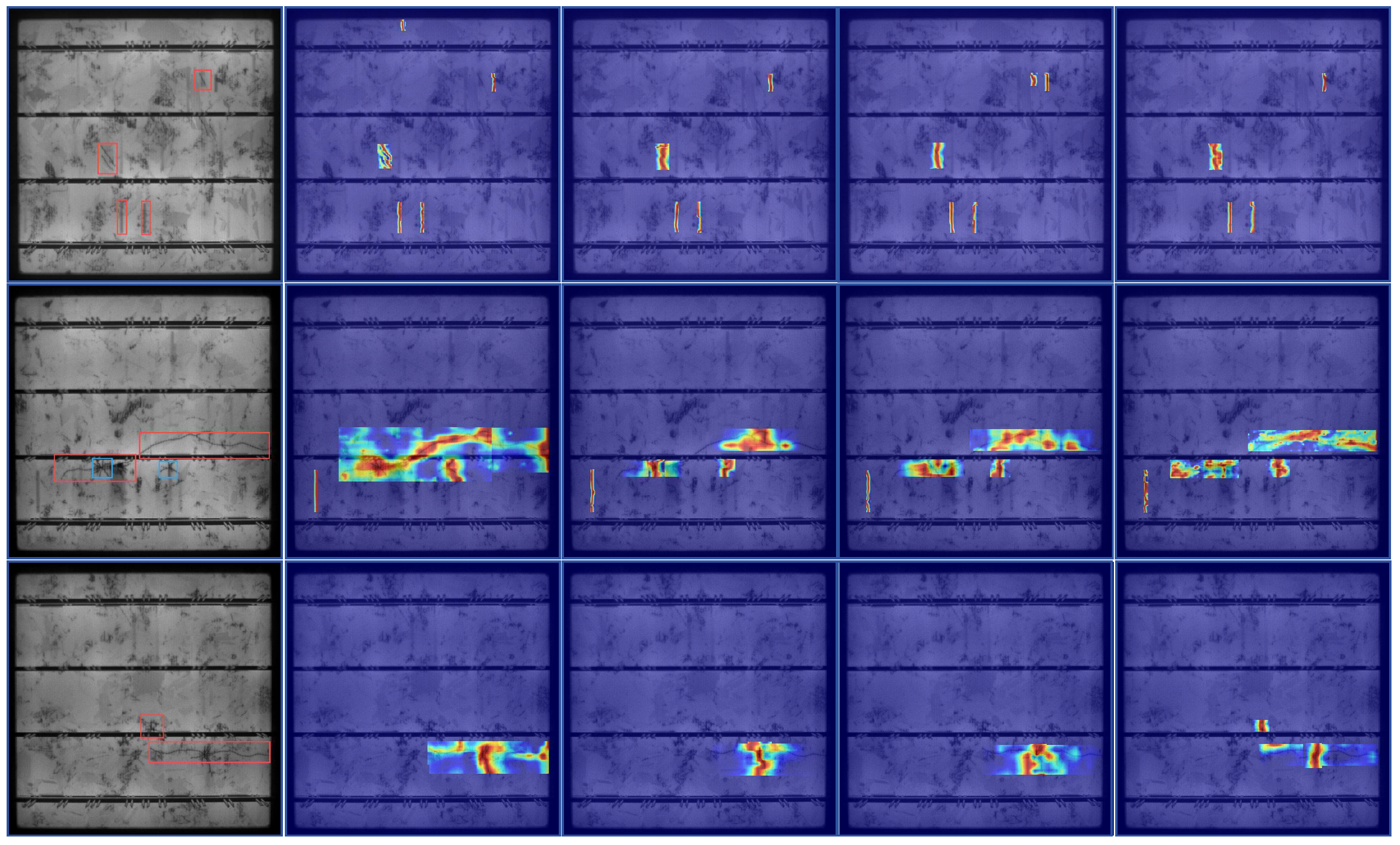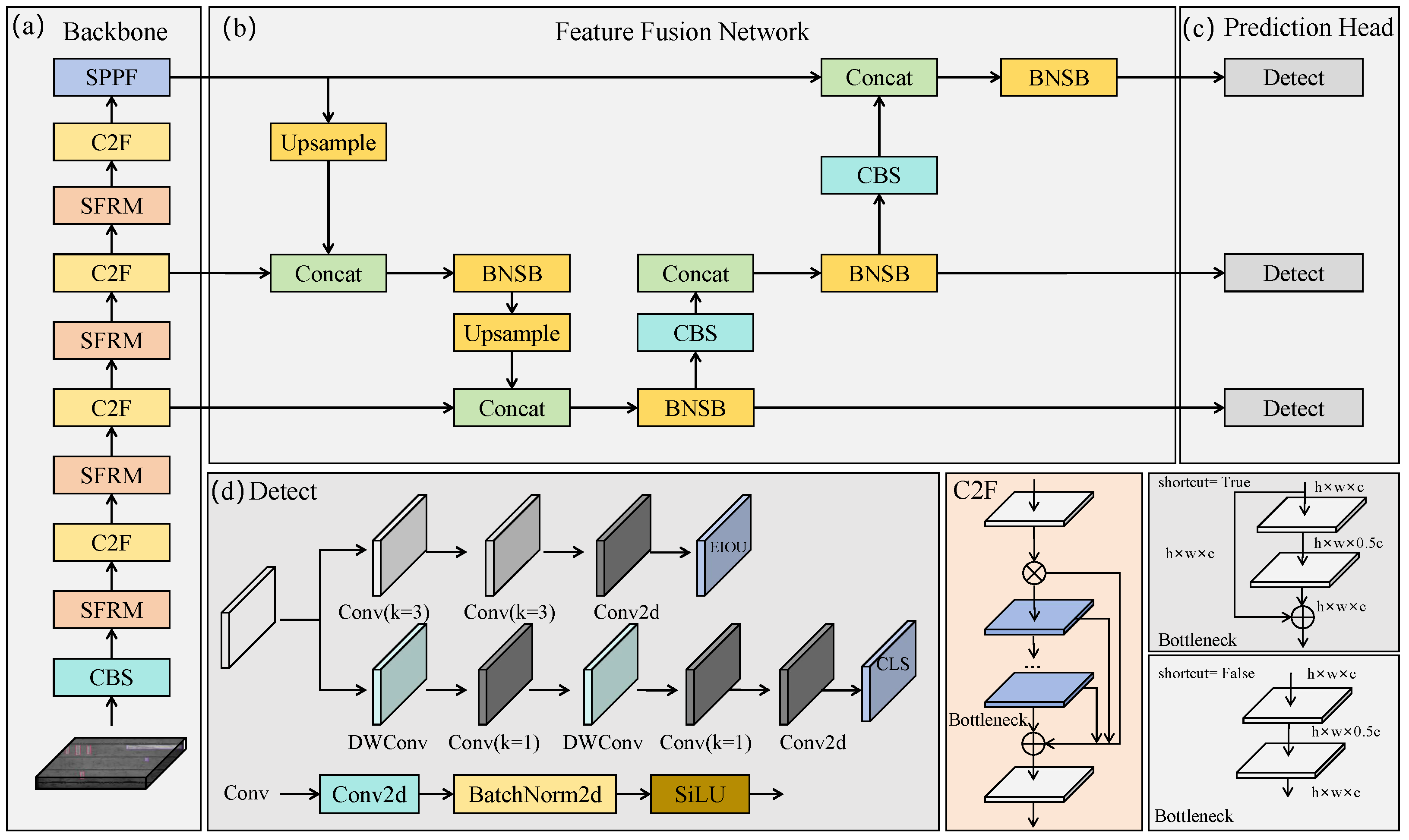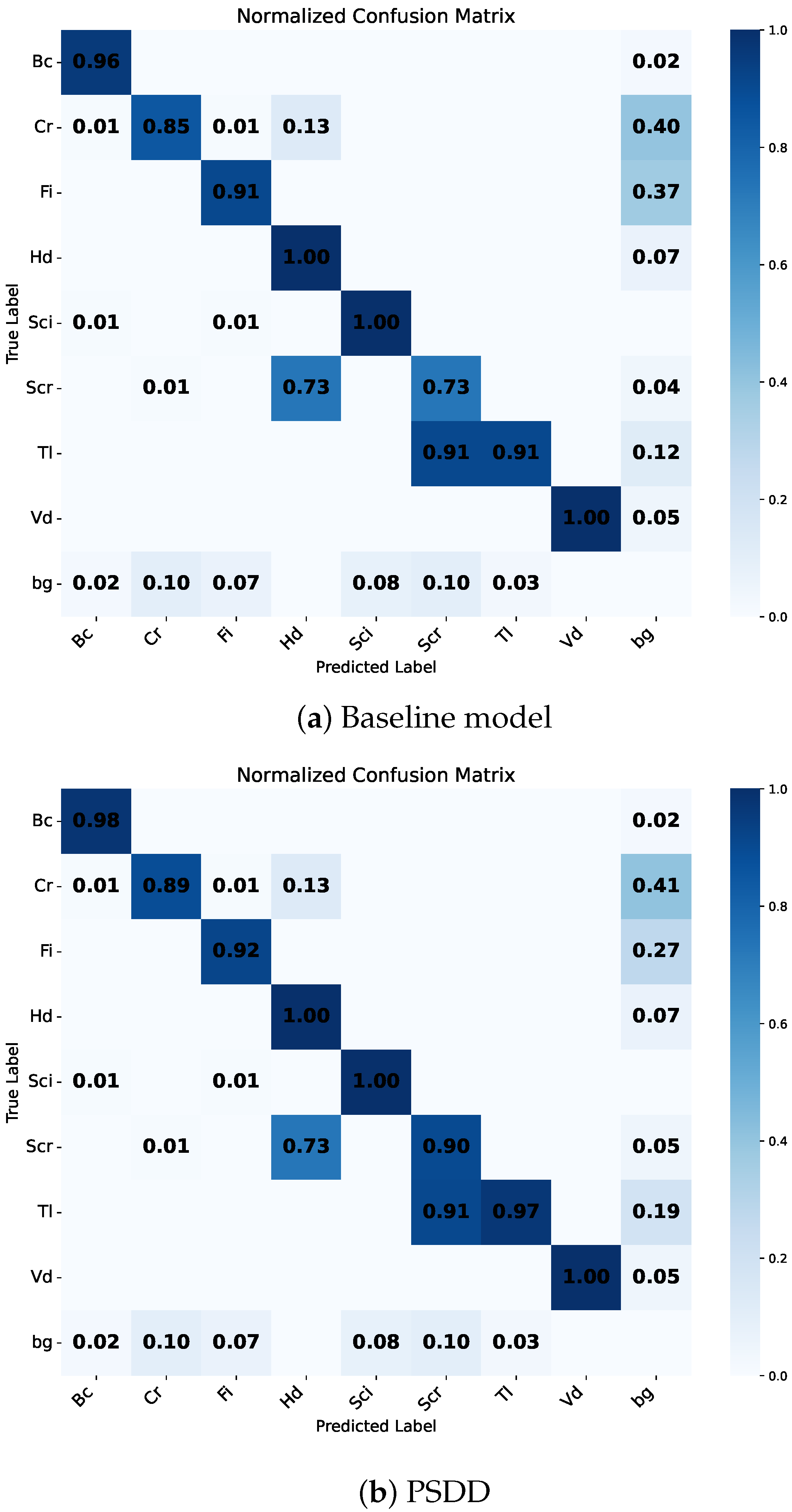Photovoltaic Cell Surface Defect Detection via Subtle Defect Enhancement and Background Suppression
Abstract
1. Introduction
- We propose a plug-and-play SFRM module that preserves subtle defect features by rearranging spatial information and enhances key feature representation through channel attention.
- We propose a dual-path BNSB, the first path uses BAM to suppress noise and highlight key features, and the second path employs residual structure to preserve the original features, thereby reducing background interference and enhancing defect saliency.
- Based on SFRM and BNSB, a novel detector PSDD is proposed to achieve efficient and accurate detection of PV cell defects by enhancing subtle features and suppressing noise.
- Extensive tests show that PSDD outperforms other advanced methods, achieving the best of 93.6% in the PVEL-AD datasets.
2. Related Work
2.1. Attention Mechanism
2.2. Photovoltaic Cell Defect Detection
3. Method
3.1. Overall Architecture
3.2. Subtle Feature Refinement Module (SFRM)
3.3. Background Noise Suppression Block (BNSB)
3.4. Loss Function
4. Experiments
4.1. Experimental Setup
4.1.1. Datasets
4.1.2. Implementing Details
4.2. Evaluation Metrics
4.3. Comparative Experiment
4.4. Ablation Experiments
4.5. Visualization
4.6. Generalization Experiments
5. Conclusions
Author Contributions
Funding
Data Availability Statement
Conflicts of Interest
References
- Zhang, S.; Cai, W.; Zheng, X.; Lv, X.; An, K.; Cao, Y.; Cheng, H.S.; Dai, J.; Dong, X.; Fan, S.; et al. Global readiness for carbon neutrality: From targets to action. Environ. Sci. Ecotechnol. 2025, 25, 100546. [Google Scholar] [CrossRef] [PubMed]
- Rana, Z.; Zamora, P.P.; Soliz, A.; Soler, D.; Reyes Cruz, V.E.; Cobos-Murcia, J.A.; Galleguillos Madrid, F.M. Solar Panel Corrosion: A Review. Int. J. Mol. Sci. 2025, 26, 5960. [Google Scholar] [CrossRef] [PubMed]
- Leung, T.L.; Willson, G.K.; Fimbres-Weihs, G.; Deng, R.; Chang, N.; Tan, V.; Abbas, A.; Ho-Baillie, A. A new perspective for evaluating circularity of photovoltaic module recycling and technology developments. Cell Rep. Phys. Sci. 2025, 6, 102547. [Google Scholar] [CrossRef]
- Fu, B.; Xiong, J.; Jv, T.; Chen, S.; Liang, T.; Ma, H.; Zhang, X.; Pan, D.; Zou, B.; Liang, G.; et al. Reaction Kinetics Regulation Suppressed Carrier Recombination Loss for High-Efficient Solution-Based Antimony Selenosulfide Photovoltaic Devices. Adv. Energy Mater. 2025, 15, 2500586. [Google Scholar] [CrossRef]
- Tarigan, E. Identification of Early Operational Defects in Photovoltaic Modules: A Case Study of a 24.9 MWp Solar PV System in Sumatra, Indonesia. Unconv. Resour. 2025, 6, 100156. [Google Scholar] [CrossRef]
- Akram, M.W.; Li, G.; Jin, Y.; Chen, X.; Zhu, C.; Zhao, X.; Khaliq, A.; Faheem, M.; Ahmad, A. CNN based automatic detection of photovoltaic cell defects in electroluminescence images. Energy 2019, 189, 116319. [Google Scholar] [CrossRef]
- Meng, Z.; Xu, S.; Wang, L.; Gong, Y.; Zhang, X.; Zhao, Y. Defect object detection algorithm for electroluminescence image defects of photovoltaic modules based on deep learning. Energy Sci. Eng. 2022, 10, 800–813. [Google Scholar] [CrossRef]
- Liu, Q.; Liu, M.; Wang, C.; Wu, Q.J. An efficient CNN-based detector for photovoltaic module cells defect detection in electroluminescence images. Sol. Energy 2024, 267, 112245. [Google Scholar] [CrossRef]
- Zhang, H.; Chang, H.; Ma, B.; Wang, N.; Chen, X. Dynamic R-CNN: Towards high quality object detection via dynamic training. In Proceedings of the Computer Vision–ECCV 2020: 16th European Conference, Glasgow, UK, 23–28 August 2020; Proceedings, Part XV 16. Springer: Berlin/Heidelberg, Germany, 2020; pp. 260–275. [Google Scholar]
- Wang, A.; Chen, H.; Liu, L.; Chen, K.; Lin, Z.; Han, J. Yolov10: Real-time end-to-end object detection. Adv. Neural Inf. Process. Syst. 2025, 37, 107984–108011. [Google Scholar]
- Carion, N.; Massa, F.; Synnaeve, G.; Usunier, N.; Kirillov, A.; Zagoruyko, S. End-to-end object detection with transformers. In Proceedings of the European Conference on Computer Vision, Glasgow, UK, 23–28 August 2020; Springer: Berlin/Heidelberg, Germany, 2020; pp. 213–229. [Google Scholar]
- Hu, J.; Shen, L.; Sun, G. Squeeze-and-excitation networks. In Proceedings of the IEEE Conference on Computer Vision and Pattern Recognition, Salt Lake City, UT, USA, 18–23 June 2018; pp. 7132–7141. [Google Scholar]
- Park, J. Bam: Bottleneck attention module. arXiv 2018, arXiv:1807.06514. [Google Scholar] [CrossRef]
- Chen, S.; Lu, Y.; Qin, G.; Hou, X.; Sun, Y. CSPD-DETR: Real-time silicon crystalline photovoltaic cell surface defect detection transformer for building photovoltaic systems. J. Build. Eng. 2025, 108, 112810. [Google Scholar] [CrossRef]
- Fioresi, J.; Colvin, D.J.; Frota, R.; Gupta, R.; Li, M.; Seigneur, H.P.; Vyas, S.; Oliveira, S.; Shah, M.; Davis, K.O. Automated defect detection and localization in photovoltaic cells using semantic segmentation of electroluminescence images. IEEE J. Photovoltaics 2021, 12, 53–61. [Google Scholar] [CrossRef]
- Ge, Z. Yolox: Exceeding yolo series in 2021. arXiv 2021, arXiv:2107.08430. [Google Scholar] [CrossRef]
- Su, B.; Chen, H.; Chen, P.; Bian, G.; Liu, K.; Liu, W. Deep learning-based solar-cell manufacturing defect detection with complementary attention network. IEEE Trans. Ind. Inform. 2020, 17, 4084–4095. [Google Scholar] [CrossRef]
- Lang, D.; Lv, Z. A PV cell defect detector combined with transformer and attention mechanism. Sci. Rep. 2024, 14, 20671. [Google Scholar] [CrossRef]
- Redmon, J.; Farhadi, A. Yolov3: An incremental improvement. arXiv 2018, arXiv:1804.02767. [Google Scholar] [CrossRef]
- Khanam, R.; Hussain, M. Yolov11: An overview of the key architectural enhancements. arXiv 2024, arXiv:2410.17725. [Google Scholar] [CrossRef]
- Zhang, Y.F.; Ren, W.; Zhang, Z.; Jia, Z.; Wang, L.; Tan, T. Focal and efficient IOU loss for accurate bounding box regression. Neurocomputing 2022, 506, 146–157. [Google Scholar] [CrossRef]
- Su, B.; Zhou, Z.; Chen, H. PVEL-AD: A large-scale open-world dataset for photovoltaic cell anomaly detection. IEEE Trans. Ind. Inform. 2022, 19, 404–413. [Google Scholar] [CrossRef]
- Ketkar, N. Stochastic gradient descent. In Deep Learning with Python: A Hands-on Introduction; Springer: Berlin/Heidelberg, Germany, 2017; pp. 113–132. [Google Scholar]
- Feng, C.; Zhong, Y.; Gao, Y.; Scott, M.R.; Huang, W. Tood: Task-aligned one-stage object detection. In Proceedings of the 2021 IEEE/CVF International Conference on Computer Vision (ICCV), Montreal, BC, Canada, 11–17 October 2021; pp. 3490–3499. [Google Scholar]
- Reis, D.; Kupec, J.; Hong, J.; Daoudi, A. Real-time flying object detection with YOLOv8. arXiv 2023, arXiv:2305.09972. [Google Scholar] [CrossRef]
- Wang, Z.; Li, C.; Xu, H.; Zhu, X. Mamba YOLO: SSMs-based YOLO for object detection. arXiv 2024, arXiv:2406.05835. [Google Scholar] [CrossRef]
- Ren, S.; He, K.; Girshick, R.; Sun, J. Faster R-CNN: Towards real-time object detection with region proposal networks. IEEE Trans. Pattern Anal. Mach. Intell. 2016, 39, 1137–1149. [Google Scholar] [CrossRef] [PubMed]
- He, K.; Gkioxari, G.; Dollár, P.; Girshick, R. Mask r-cnn. In Proceedings of the IEEE International Conference on Computer Vision, Venice, Italy, 22–29 October 2017; pp. 2961–2969. [Google Scholar]
- Vu, T.; Jang, H.; Pham, T.X.; Yoo, C. Cascade rpn: Delving into high-quality region proposal network with adaptive convolution. Adv. Neural Inf. Process. Syst. 2019, 32. [Google Scholar] [CrossRef]
- Mustikovela, S.K.; De Mello, S.; Prakash, A.; Iqbal, U.; Liu, S.; Nguyen-Phuoc, T.; Rother, C.; Kautz, J. Self-supervised object detection via generative image synthesis. In Proceedings of the IEEE/CVF International Conference on Computer Vision, Virtual, 11–17 October 2021; pp. 8609–8618. [Google Scholar]
- Joseph, K.; Rajasegaran, J.; Khan, S.; Khan, F.S.; Balasubramanian, V.N. Incremental object detection via meta-learning. IEEE Trans. Pattern Anal. Mach. Intell. 2021, 44, 9209–9216. [Google Scholar] [CrossRef]
- Zhu, X.; Su, W.; Lu, L.; Li, B.; Wang, X.; Dai, J. Deformable detr: Deformable transformers for end-to-end object detection. arXiv 2020, arXiv:2010.04159. [Google Scholar]
- Zhao, Y.; Lv, W.; Xu, S.; Wei, J.; Wang, G.; Dang, Q.; Liu, Y.; Chen, J. Detrs beat yolos on real-time object detection. In Proceedings of the IEEE/CVF Conference on Computer Vision and Pattern Recognition, Seattle, WA, USA, 16–22 June 2024; pp. 16965–16974. [Google Scholar]
- Liu, Z.; Lin, Y.; Cao, Y.; Hu, H.; Wei, Y.; Zhang, Z.; Lin, S.; Guo, B. Swin transformer: Hierarchical vision transformer using shifted windows. In Proceedings of the IEEE/CVF International Conference on Computer Vision, Montreal, BC, Canada, 11–17 October 2021; pp. 10012–10022. [Google Scholar]
- Zhang, H.; Li, F.; Liu, S.; Zhang, L.; Su, H.; Zhu, J.; Ni, L.M.; Shum, H.Y. Dino: Detr with improved denoising anchor boxes for end-to-end object detection. arXiv 2022, arXiv:2203.03605. [Google Scholar]
- Yao, T.; Pan, Y.; Li, Y.; Ngo, C.W.; Mei, T. Wave-vit: Unifying wavelet and transformers for visual representation learning. In Proceedings of the European Conference on Computer Vision, Tel Aviv, Israel, 23–27 October 2022; Springer: Berlin/Heidelberg, Germany, 2022; pp. 328–345. [Google Scholar]
- Zhou, B.; Khosla, A.; Lapedriza, A.; Oliva, A.; Torralba, A. Learning deep features for discriminative localization. In Proceedings of the IEEE Conference on Computer Vision and Pattern Recognition, Las Vegas, NV, USA, 27–30 June 2016; pp. 2921–2929. [Google Scholar]
- Wang, C.Y.; Yeh, I.H.; Mark Liao, H.Y. Yolov9: Learning what you want to learn using programmable gradient information. In Proceedings of the European Conference on Computer Vision, Milan, Italy, 29 September–4 October 2024; Springer: Berlin/Heidelberg, Germany, 2024; pp. 1–21. [Google Scholar]
- Song, K.; Yan, Y. A noise robust method based on completed local binary patterns for hot-rolled steel strip surface defects. Appl. Surf. Sci. 2013, 285, 858–864. [Google Scholar] [CrossRef]








| Model | P | R | Params (M) | FLOPs (G) | Speed (ms) | Bc | Cr | Scr | Fi | Tl | Sci | Hd | Vd | ||
|---|---|---|---|---|---|---|---|---|---|---|---|---|---|---|---|
| Single-stage Detectors | |||||||||||||||
| TOOD [24] | 66.0 | 47.9 | 61.3 | 62.7 | 3.7 | 17.8 | 5.9 | 98.0 | 75.2 | 78.1 | 89.3 | 88.2 | 99.2 | – | – |
| Yolov8 [25] | 87.4 | 61.9 | 90.3 | 81.5 | 3.5 | 8.1 | 9.0 | 97.0 | 78.9 | 73.2 | 88.9 | 89.7 | 99.5 | 98.8 | 73.0 |
| Yolov10 [10] | 79.2 | 51.1 | 78.4 | 72.6 | 6.5 | 16.6 | 17.4 | 98.6 | 77.4 | 79.2 | 90.6 | 91.2 | 99.5 | 98.5 | 89.4 |
| Yolov11 [20] | 90.6 | 51.7 | 78.9 | 72.9 | 8.0 | 14.5 | 12.0 | 98.3 | 83.8 | 83.7 | 89.7 | 90.8 | 99.5 | 98.5 | 74.4 |
| YoloX [16] | 90.3 | 62.2 | 85.7 | 87.1 | 9.0 | 7.0 | 20.0 | 98.4 | 80.6 | 81.8 | 89.8 | 89.8 | 99.5 | 98.6 | 83.9 |
| Mamba YOLO [26] | 91.6 | 62.1 | 87.9 | 85.5 | 5.8 | 13.2 | 14.4 | 98.8 | 80.7 | 80.7 | 89.9 | 90.8 | 99.4 | 96.2 | 96.9 |
| Two-stage Detectors | |||||||||||||||
| Dynamic R-CNN [9] | 89.8 | 62.3 | 83.2 | 88.8 | 45.0 | 46.3 | 24.0 | 98.8 | 76.3 | 68.5 | 90.3 | 82.4 | 99.7 | 81.6 | – |
| Faster R-CNN [27] | 79.7 | 54.0 | 77.0 | 75.9 | 23.3 | 26.4 | 22.0 | 97.5 | 75.2 | 82.7 | 89.3 | 89.4 | 99.2 | 98.5 | – |
| Mask R-CNN [28] | 90.1 | 57.6 | 85.5 | 82.5 | 30.0 | 33.3 | 26.0 | 98.1 | 77.7 | 83.9 | 88.7 | 88.4 | 98.0 | 96.7 | 89.4 |
| Cascade RPN [29] | 87.8 | 61.9 | 87.6 | 79.5 | 47.3 | 136.6 | 35.5 | 98.8 | 79.6 | 82.2 | 89.7 | 88.9 | 99.5 | 96.9 | 67.9 |
| SSOD [30] | 77.3 | 52.4 | 76.9 | 71.3 | 26.4 | 19.2 | 25.6 | 98.0 | 80.7 | 80.8 | 83.6 | 88.2 | 98.5 | 89.3 | – |
| IOD [31] | 87.8 | 61.8 | 89.2 | 80.4 | 9.0 | 14.5 | 19.2 | 98.4 | 79.5 | 82.0 | 87.9 | 88.9 | 98.4 | 97.2 | 70.2 |
| Transformer-based Detectors | |||||||||||||||
| DETR [11] | 90.4 | 61.2 | 78.9 | 89.7 | 41.6 | 60.5 | 27.0 | 95.8 | 80.1 | 71.8 | 87.4 | 90.0 | 99.2 | 86.8 | 99.5 |
| Deformable DETR [32] | 91.2 | 61.9 | 85.4 | 87.0 | 39.9 | 52.4 | 24.5 | 97.7 | 80.96 | 83.8 | 89.7 | 90.0 | 99.4 | 98.5 | 90.8 |
| Rt-DETR [33] | 89.1 | 63.0 | 89.3 | 78.9 | 19.9 | 57.0 | 20.7 | 98.3 | 82.1 | 78.9 | 89.9 | 90.3 | 98.3 | 97.5 | 77.4 |
| Swin-Transformer [34] | 78.4 | 54.6 | 71.3 | 87.1 | 54.6 | 136.0 | 33.7 | 89.9 | 60.0 | 42.1 | 88.9 | 74.8 | 99.6 | 99.6 | 69.7 |
| DINO [35] | 90.4 | 59.0 | 83.2 | 87.2 | 59.3 | 123.0 | 32.0 | 98.7 | 80.1 | 86.8 | 89.9 | 91.1 | 99.5 | 89.3 | 86.7 |
| Wave-ViT [36] | 90.6 | 61.8 | 85.9 | 88.3 | 66.1 | 96.4 | 12.4 | 98.6 | 78.2 | 81.0 | 89.9 | 91.1 | 99.5 | 96.3 | 90.6 |
| PSDD (Ours) | 93.6 | 65.3 | 90.8 | 89.2 | 4.0 | 13.8 | 10.0 | 98.8 | 84.7 | 87.0 | 90.4 | 91.3 | 99.5 | 99.3 | 99.4 |
| Module | P | R | Bc | Cr | Scr | Fi | Tl | Sci | Hd | Vd | ||||
|---|---|---|---|---|---|---|---|---|---|---|---|---|---|---|
| Baseline | SFRM | BNSB | (%) | (%) | (%) | (%) | (%) | (%) | (%) | (%) | (%) | (%) | (%) | (%) |
| ✓ | – | – | 87.4 | 61.9 | 83.6 | 81.5 | 97.0 | 78.9 | 73.2 | 77.2 | 89.7 | 99.5 | 98.8 | 73.0 |
| ✓ | ✓ | – | 89.9 | 62.7 | 85.2 | 87.9 | 98.3 | 84.7 | 81.2 | 89.6 | 89.4 | 99.3 | 99.4 | 77.5 |
| ✓ | – | ✓ | 92.1 | 64.5 | 87.2 | 85.3 | 98.2 | 80.8 | 81.0 | 90.9 | 90.4 | 99.5 | 99.4 | 96.8 |
| ✓ | ✓ | ✓ | 93.6 | 65.3 | 90.8 | 89.2 | 98.8 | 84.7 | 87.0 | 90.4 | 91.3 | 99.5 | 99.3 | 99.4 |
| Model | P | R | Cr | In | Pa | Ps | Rs | Sc | |
|---|---|---|---|---|---|---|---|---|---|
| TOOD [24] | 72.4 | 75.7 | 68.1 | 42.8 | 71.5 | 87.7 | 80.9 | 59.9 | 91.9 |
| Yolov8 [25] | 77.3 | 75.4 | 70.8 | 49.7 | 77.9 | 90.1 | 88.0 | 63.7 | 94.7 |
| Yolov10 [38] | 74.2 | 68.3 | 69.7 | 40.2 | 74.3 | 91.9 | 83.3 | 61.4 | 94.4 |
| Yolov11 [20] | 79.4 | 79.1 | 71.7 | 51.0 | 79.5 | 92.3 | 87.3 | 70.9 | 95.2 |
| YoloX [16] | 74.5 | 70.4 | 69.7 | 37.8 | 79.3 | 90.3 | 86.0 | 60.6 | 92.5 |
| Faster R-CNN [27] | 70.9 | 67.4 | 66.7 | 36.2 | 74.2 | 89.1 | 77.9 | 57.0 | 90.9 |
| Rt-DETR [33] | 70.6 | 69.3 | 68.1 | 33.3 | 73.5 | 88.0 | 81.7 | 55.4 | 91.6 |
| Deformable DETR [32] | 71.1 | 70.3 | 67.2 | 30.5 | 76.3 | 89.1 | 82.7 | 56.2 | 91.6 |
| Swin-Transformer [34] | 70.3 | 69.9 | 65.3 | 31.8 | 74.2 | 88.0 | 79.3 | 57.2 | 90.9 |
| Mamba YOLO [26] | 69.6 | 72.3 | 63.7 | 30.7 | 73.8 | 88.7 | 76.5 | 58.0 | 90.1 |
| PSDD (Ours) | 80.9 | 81.4 | 80.6 | 52.4 | 84.1 | 93.4 | 90.6 | 68.3 | 96.4 |
Disclaimer/Publisher’s Note: The statements, opinions and data contained in all publications are solely those of the individual author(s) and contributor(s) and not of MDPI and/or the editor(s). MDPI and/or the editor(s) disclaim responsibility for any injury to people or property resulting from any ideas, methods, instructions or products referred to in the content. |
© 2025 by the authors. Licensee MDPI, Basel, Switzerland. This article is an open access article distributed under the terms and conditions of the Creative Commons Attribution (CC BY) license (https://creativecommons.org/licenses/by/4.0/).
Share and Cite
Sun, Y.; Huang, G.; Xu, C.; Guo, H.; Feng, Y. Photovoltaic Cell Surface Defect Detection via Subtle Defect Enhancement and Background Suppression. Micromachines 2025, 16, 1003. https://doi.org/10.3390/mi16091003
Sun Y, Huang G, Xu C, Guo H, Feng Y. Photovoltaic Cell Surface Defect Detection via Subtle Defect Enhancement and Background Suppression. Micromachines. 2025; 16(9):1003. https://doi.org/10.3390/mi16091003
Chicago/Turabian StyleSun, Yange, Guangxu Huang, Chenglong Xu, Huaping Guo, and Yan Feng. 2025. "Photovoltaic Cell Surface Defect Detection via Subtle Defect Enhancement and Background Suppression" Micromachines 16, no. 9: 1003. https://doi.org/10.3390/mi16091003
APA StyleSun, Y., Huang, G., Xu, C., Guo, H., & Feng, Y. (2025). Photovoltaic Cell Surface Defect Detection via Subtle Defect Enhancement and Background Suppression. Micromachines, 16(9), 1003. https://doi.org/10.3390/mi16091003






